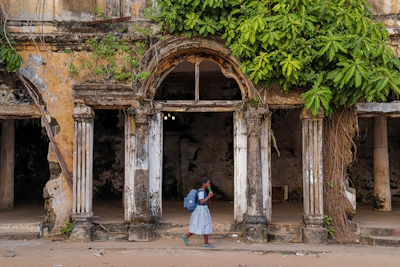Grand-Bassam

The historic town of Grand-Bassam is an example of rational town planning from the colonial period.
Built in the 19th century, this seaport was the French colonial capital of Cote d'Ivoire. Europeans and Africans lived divided into separate residential quarters. It had commercial and administrative zones, in which historic buildings in a sober and functional colonial style have been preserved. The indigenous N’zima village and its vernacular architecture already existed before colonization and were later incorporated into the urban plan.
Community Perspective: Lauren visited in 2019, and found it easily accessible though without tourist infrastructure.
Map of Grand-Bassam
Load mapCommunity Reviews
Little Lauren Travels

Grand Bassam is a beach town about 45 minutes away from Abidjan. Its UNESCO status comes from the fact that it was a French colonial capital for a few years in the late 1800s. The capital was moved inland soon after it was established due to an outbreak of yellow fever, leaving behind a cluster of French colonial buildings that still remain today. Most of the site is on a barrier island/isthmus, which is walkable via a bridge from the modern town. The part on the isthmus is still sparsely inhabited, but has the eerie feeling of a ghost town due to the number of abandoned buildings. There was significant flooding in Grand Bassam in October 2019. When I visited in mid-November, the water levels were still high on the inland side, but water had cleared from the streets and there were few signs of damage.
As is a theme with some of the sites in Africa, I wish there was better upkeep and more information online. Although a few key buildings (like the costume museum in the former governor's palace) have been preserved, many of the buildings were deteriorating and some were abandoned. The upside is that there certainly were not a lot of tourists, and there seemed to be no tourist infrastructure when we went. But it was safe and easy to walk around. We wandered around for a few hours, gave a boy a tip to show us around one of the abandoned buildings, found one of the few restaurants for lunch, and then headed to one of the beachfront hotels for a drink by the water. All in all, a successful day, and an easy trip.
Date of Visit: November 2019
Rating: Three stars. Many of the remnants of colonial Africa are disappearing to new construction or simply haven’t been preserved. Because it became a sleepy village almost 100 years ago as the capital and commercial center moved to Abidjan, Grand Bassam, is one of the few examples of a preserved colonial town in West Africa. And although it might not be as visually impressive as some of the wonderful sites, it is an important piece of global history to preserve. Also, many sites in Africa are relatively remote and take a week’s worth of travel. Grand Bassam can easily be visited on a day trip from the capital Abidjan. The nice beaches in and around the town don't hurt either! But, the cluster of buildings is quickly deteriorating and I had difficulty learning much about the history of the place, other than from a short article on Wikipedia and the high-level description on the UNESCO website.
Logistics: I wasn't able to find a lot of information online about Grand Bassam when planning the trip, but getting there proved to be quite easy. We did this as a day trip from Abidjan. We had no problems finding a taxi to take us there from Abidjan or finding a return taxi to take us back. We paid 10,000 XOF (about $17 USD) there and 12,000 (about $20 USD) to return, which seemed like a fair price. (The hotel doorman tried to get us to pay 40,000 XOF, which seemed ridiculous, and proved to be, considering that the first cab driver we found on the street offered 10,000 XOF). We got dropped off at the main traffic circle in Grand Bassam, and it was about a ten minute walk to the lighthouse, and then another ten minute walk to the isthmus where most of the colonial buildings are located.
The official UNESCO description inscription describes the N'zima African fishing village and the lighthouse as part of the UNESCO site. It wasn't clear to us where the fishing village was and if it was separate from the town. The lighthouse is on the mainland and under construction to be restored (it looks a lot better than the pictures on Google from a few years ago!). We walked by it but there was no signage and it did not appear open.
Sign: As you cross the bridge into the isthmus from the modern town, there is a brown sign saying “Welcome to Grand Bassam, World Heritage of UNESCO” in French and English.
Site Info
- Full Name
- Historic Town of Grand-Bassam
- Unesco ID
- 1322
- Country
- Côte d'Ivoire
- Inscribed
- 2012
- Type
- Cultural
- Criteria
-
3 4
- Categories
- Urban landscape - Colonial
- Link
- By ID
Site History
2012 Advisory Body overruled
Referral suggested by ICOMOS
2012 Inscribed
2009 Referred
Include the N'zima village, and legal/operational/management issues
Site Links
Unesco Website
Official Website
In the News
Connections
The site has 11 connections
Constructions
Damaged
Geography
History
Human Activity
Religion and Belief
Timeline
Trivia
WHS on Other Lists
Visitors
31 Community Members have visited.
The Plaque